|

July 28, 2009
from
EMSNews Website
|
The
Late Heavy Bombardment
(commonly referred to as the lunar cataclysm, or LHB) is
a period of time approximately 4.1 to 3.8 billion years
ago (Ga) during which a large number of impact craters
are believed to have formed on the Moon, and by
inference on Earth, Mercury, Venus, and Mars as well.
The evidence for
this event comes primarily from the dating of lunar
samples, which indicates that most impact melt rocks
formed in this very narrow interval of time. |
Another comet hit Jupiter exactly on the
anniversary of the previous comet hit we saw 15 years ago.
Also, the
Spitzer Space Telescope took a stunning picture of a galaxy that is
in the process of merging with a smaller galaxy, triggering massive
star formation activity around a very large black hole.
It should
now be obvious that not only do all galaxies have black holes, all
galaxies are falling towards one and another, a paradox of the
expanding universe that really isn't expanding in this regard, but
rather, is falling into each other.
Jupiter - Our Cosmic
Protector?
NYTimes
July 25, 2009
An object, probably a comet that nobody saw coming, plowed into the
giant planet's colorful cloud tops sometime Sunday, splashing up
debris and leaving a black eye the size of the Pacific Ocean.

This
was the second time in 15 years that this had happened.
The whole
world was watching when
Comet Shoemaker-Levy 9 fell apart and its
pieces crashed into Jupiter in 1994, leaving Earth-size marks that
persisted up to a year.
That's Jupiter doing its cosmic job, astronomers like to say. Better
it than us. Part of what makes the Earth such a nice place to live,
the story goes, is that Jupiter's overbearing gravity acts as a
gravitational shield deflecting incoming space junk, mainly comets,
away from the inner solar system where it could do for us what an
asteroid apparently did for the dinosaurs 65 million years ago.
Indeed, astronomers look for similar configurations
- a giant outer
planet with room for smaller planets in closer to the home stars - in other planetary systems as an indication of their hospitableness
to life.
Since the beginning of our solar system, the gravitational pull of
the sun has sucked in lots of stuff. We know from looking at the
universe that there are these immense sheets of dark stuff that
blocks the light of the stars. We call this 'dust lanes' for example
and all spiral galaxies have these dust lanes. The dust looks fine
when seen from light-years away.
But we have no idea how big this
stuff is, when seen close up compared to a human scale. For example,
is the immense seas of dense dust made up of stuff that is the size
of grains of sand or the size of planets?
We know there is this fine dust which varies in amount as the solar
system rotates around the black hole in the center of the Milky Way.
Stars that are exploding create this finer dust.
Unseen or unnoticed
by humans, a fine rain of dust falls into our planet every day.
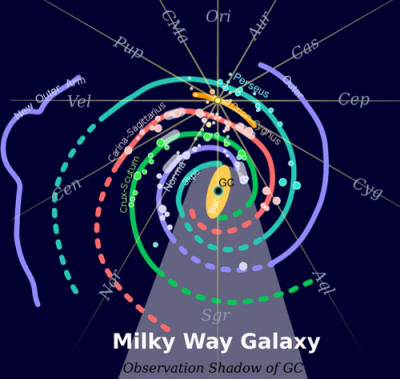
This Milky Way picture shows the
solar system relative to the rest of our galaxy.
Note that we are in
the Orion arm which used to the outermost arm of the galaxy back 5
billion years ago when it first formed.
There is some theories that
the sun was part of a small star cluster that was moving along with
sheets of dust and when it was pulled into the gravitational pool of
the Milky Way's central black hole, the compression of the matter
surrounding this hobbit star cluster caused a sudden surge in
star-making.
Fountain of Mysterious Space Dust Found
SPACE.com
10 February 2009
In fact our solar system is currently
experiencing a cosmic dust storm
with at least three times as much dust passing through compared
to just a few years ago, owing to a periodic weakening of the sun's
magnetic field.
And sometime in the next 10,000 years, we'll plow
through the G-cloud, a region of dust more dense than the one we're
in now.
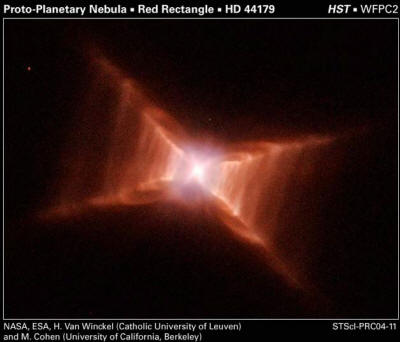
Astronomers have struggled for a conclusive answer as to where all
this dust comes from.
Since the creation of the sun, we have rotated closer to the
galactic core.
The sheets of dust that surround this core are still
ahead of us, we can see this at night when we look at the Milky Way.
Most of the starlight from this system is blocked by immense, nearly
unimaginable amounts of dust, rocks and asteroids all being squeezed
into a smaller and smaller space.
When we look outwards, away from
the galactic core, we see flags and rags of this dark debris which
means, we are surrounded by this stuff.
It obviously impacts on our own sun.
There are many questions about all these things.
Within
the astronomical community, there is much debate about
global
warming with significant dissent that perhaps it may be necessary
for us to have global warming if we are to avoid another spell of
ice age coldness. Conditions around us can change.
Using Jupiter to
suck up most of the debris that is hurtling towards the sun won't
work so well if we go into a major dust lane episode at the same
time that Betelgeuse blows up.
Betelgeuse
Wikipedia
It is possible that Betelgeuse will become a supernova, which
will be the brightest ever recorded, outshining the Moon in the
night sky. Considering its size and age of 8.5 million years,
old for its size class, it may explode within the next thousand
years.
Since its rotational axis is not toward the Earth and
also because of its 640 light year distance, Betelgeuse's
supernova will not cause a
gamma ray burst in the direction of Earth
large enough to damage its ecosystem.
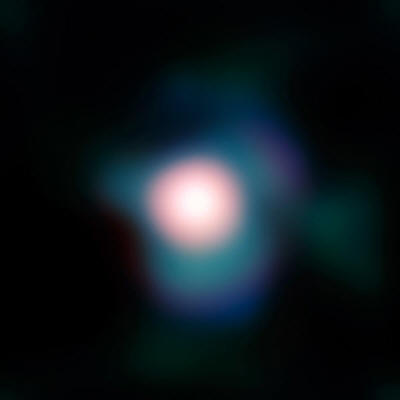
Nobel Laureate Charles Townes announced evidence that 15 consecutive
years of stellar contraction has been observed by UC Berkeley's
Infrared Spatial Interferometer (ISI)
atop Mt. Wilson Observatory in Southern California.
Reported on June 9, 2009, the star
has shrunk 15% since 1993 with an increasing rate. The average
speed at which the radius of the star is shrinking over the last
15 years is approximately 470-490 miles per hour.
According to the university, Betelgeuse's radius is about 5.5
AUs,
and the star's radius has shrunk by a distance equal to half an
astronomical unit, or about the orbit of Venus.
Some theorists have speculated that this behavior is expected for a
star at the beginning of the gravitational collapse at the end of
its life. The mass of Betelgeuse puts it in range
to become a neutron star or possibly a black hole.
If this happens during a passage through heightened dust conditions,
will this cause a compression of dust outwards from around
Betelgeuse and towards our own solar system?
We know that all star
deaths, there is this ring of dust that is created by the star and
perhaps, the dust that surrounds the star's vicinity also is pushed
outwards and forms a ring around the dead star. So this event could
trigger a much, much higher rate of incoming star debris of all
sorts.
By the way, my astronomer grandfather loved to tell me,
'You have exactly 8
minutes of time after the sun blows up, to know it blew up. Then
it is too late.'
Ah, fun facts for small children!
Well,
Betelgeuse may have already blown up long ago, back in the Middle
Ages during the Black Death! When we find out this has happened, it
is long after the fact.
Earth's Bombardment by Asteroids 3.9 Billion Years Ago May Have
Enhanced Early Life, Says CU Study
University of
Colorado at Boulder
May 20, 2009
Impact evidence from lunar samples, meteorites and the pockmarked
surfaces of the inner planets paints a picture of a violent
environment in the solar system during the
Hadean Eon 4.5 to 3.8
billion years ago, particularly through a cataclysmic event known as
the
Late Heavy Bombardment about 3.9 billion years ago.
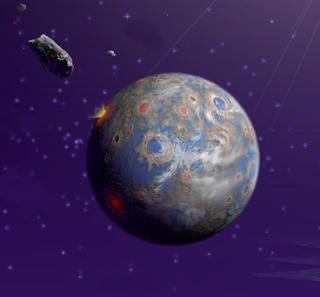
Although
many believe the bombardment would have sterilized Earth, the new
study shows it would have melted only a fraction of Earth's crust,
and that microbes could well have survived in subsurface habitats,
insulated from the destruction.
"These new results push back the possible beginnings of life on
Earth to well before the bombardment period 3.9 billion years ago,"
said CU-Boulder Research Associate Oleg Abramov.
"It opens up the
possibility that life emerged as far back as 4.4 billion years ago,
about the time the first oceans are thought to have formed."…
The 3-D models allowed Abramov and
Mojzsis to monitor temperatures
beneath individual craters to assess heating and cooling of the
crust following large impacts in order to evaluate habitability,
said Abramov.
The study indicated that less than 25 percent of
Earth's crust would have melted during such a bombardment.
The
Late Heavy Bombardment
event was probably when a planet was so
disrupted by gravitational pull combined with exterior events, it
blew up and its debris fell towards the sun, peppering all the inner
planets.
The
asteroid belt is probably testimony of this lost
planet.
Seeing that generally, the planets are all gas giants after
the asteroid belt and none are gas giants inside this belt is most
interesting and there are various theories to account for all this.
The main thing is, we live in a danger zone and the gas giants
protect us to some degree but certainly, not totally.
The Day The Moon Was Made
- 24 Hours of Chaos
SPACE
15 August 2001
A dark, lifeless object less than half as massive as Earth careens
around a newborn Sun.
It is one of many planet-sized bodies hoping
for a long career. But its orbit is shaky. It's future grim. It is a
character actor on the grand stage of the solar system, a player of
great ultimate consequence but one destined to never see its name in
lights.
This doomed "protoplanet" travels a path that crosses the orbits of
similar objects and, ultimately, cannot last.
Eventually, the
nameless protoplanet meets up with a fledgling Earth.
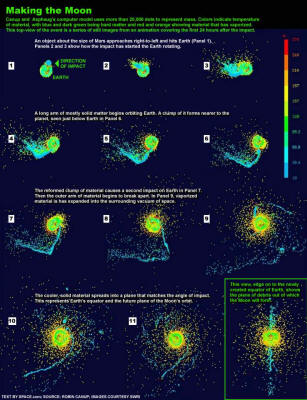
It is not a head-on collision, but rather a glancing blow.
The
impact imparts what astronomers call angular momentum into the
system. It sets Earth to spinning on its axis and creates a Moon
that would go round and round the host planet for billions of years.
The shock of the impact strips material from the outer layers of
Earth and the impacting object. The mostly iron cores of both bodies
meld into Earth's core.
It is like a compact car merging onto the
highway and colliding with an S.U.V. - glass, trim and hubcaps fly,
but the two chassis remain hopelessly tangled.
All told, about 2 percent of the combined mass of the objects
- mostly rocky stuff that's largely bereft of iron - begins to orbit
the Earth. About half of this eventually becomes the Moon.
Some of the stripped material is heated so fantastically that it
vaporizes and expands into the surrounding vacuum of space.
"The material that was vaporized expands into a cloud that envelops
the whole planet," Canup explained.
Meanwhile, a long arm of solid matter is winging its way around
Earth.
Some of it develops into a clump that slams back into the
planet. The rest is flung into orbit, all pretty much along a plane
that mimics the path of the incoming object.
This plane slices
through what is now Earth's equator, and it is roughly the same
plane along which the Moon orbits.
Note that iron didn't leave the Earth. This is due to it being
heavy.
Mars is similar to the moon in this way, incidentally and
this leads me to a series of thoughts that are open to question but
are well within the bounds of natural probability:

What is interesting is, Mars didn't do this.
Mars is half
the size of earth but only a fraction (Ratio Mars/Earth = 0.107) of
earth's weight. Venus is nearly the same size as earth and unlike
Mars, has a gaseous atmosphere which all the planets beyond Mercury
have.
Asteroid belt
Wikipedia
The current asteroid belt is believed to contain only a small
fraction of the mass of the primordial belt. Computer simulations
suggest that the original asteroid belt may have contained mass
equivalent to the Earth.

Primarily because of gravitational
perturbations, most of the material was ejected from the belt
within about a million years of formation, leaving behind less
than 0.1% of the original mass.
Since their formation, the size
distribution of the asteroid belt has remained relatively
stable: there has been no significant increase or decrease in
the typical dimensions of the main belt asteroids.
It is very interesting that the possibility that the asteroid belt
was once an Earth/Venus sized entity which then disintegrated due to
Jupiter.
But this doesn't fit all possible models. If nothing else,
Nature loves logic and numbers. No system is more rational than the
systems set up by Nature, itself. So, logically speaking, Mars
should be the same mass category as Earth and Venus.
Instead, it is
dwarfed by all the other planets except for Mercury. Certainly, if
the asteroid belt was once the mass of Earth, then this means there
was uniformity from Venus, Earth and then Mars and this is missing.
We must presume that something altered the size of the two larger
inner ring planets.
That is, there were collisions with more than
one 'Mars' sized planet during the
Late Heavy Bombardment.
Jupiter
Wikipedia
Jupiter is 2.5 times more massive than all the other planets in our
Solar System combined - this is so massive that its barycenter with
the Sun actually lies above the Sun's surface (1.068 solar radii
from the Sun's center).
Although this planet dwarfs the Earth (with
a diameter 11 times as great) it is considerably less dense.
Jupiter's volume is equal to 1,317 Earths, yet is only 318 times as
massive. A Jupiter mass (MJ) is used to describe masses of
other gas giant planets, particularly extrasolar planets.
Theoretical models indicate that if Jupiter had much more mass than
it does at present, the planet would shrink.
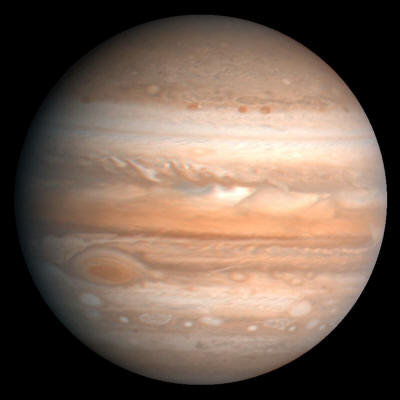
For small changes in
mass, the radius would not change appreciably, and above about four
Jupiter masses the interior would become so much more compressed
under the increased gravitation force that the planet's volume would
actually decrease despite the increasing amount of matter.
As a
result, Jupiter is thought to have about as large a diameter as a
planet of its composition and evolutionary history can achieve. The
process of further shrinkage with increasing mass would continue
until appreciable stellar ignition is achieved as in high-mass brown
dwarfs around 50 Jupiter masses.
This has led some astronomers
to term it a "failed star", although it is unclear whether or not
the processes involved in the formation of planets like Jupiter are
similar to the processes involved in the formation of multiple star
systems.
It is entirely possible that Jupiter's core could have been very
similar to Earth and Venus but for some reason, at the same time as
the
Late Heavy Bombardment
period began, this planet collected a
runaway amount of interstellar gasses (from a nearby collapsed
star?) which nearly turned it into a sun. This is very, very
possible because we see, all over the place, dual star systems.
Often, with a smaller star orbiting a larger one. Indeed, the times
we have detected planets in other star systems, these are often even
bigger than Jupiter.
When Jupiter suddenly began to bulk up in size with this gas
collection business, this may have caused the Asteroid planet to
suddenly explode. That is, the inner core blew outwards which is why
there is a certain degree of uniformity with the size of the
Asteroid Belt debris.
This explosion probably also stripped Mars of
much of its own atmosphere due to Mars being significantly smaller
than the other inner planets, the stripping of the atmosphere due to
this explosive event probably reduced the mass of Mars to the point,
it couldn't attract enough of the mass bombardment of this event,
90% of the debris of the Asteroid planet falling towards the sun.
So
Mars not only didn't grow due to this event, it lost the chance to
double its own iron core. For we suspect that this missing planet
had a considerable iron core.
The addition of this iron base may have increased the gas shell of
Venus and Earth, too. Another possibility could be, and this is a
very wild guess, that Mars is the moon of this missing planet that
once was in the Asteroid region.
The similarity of the materials of
Mars with Lunar material means both may have been made the same way:
-
Before the Late Heavy Bombardment, perhaps Mars was split from the
planet Asteroid during the same chaotic mess that created the
Earth's own moon?
-
Perhaps this planet was accreting the same mass
and materials as Jupiter and between them, they couldn't sustain
this accumulation?
-
And maybe this explosion caused the gasses to
fall into Jupiter's orbit which is why it is so much bigger than all
the other planets?
-
While the heavy mass fell into Earth and Venus?
This month, old NASA sea dogs called for us to go to
Mars, yet
again.
But if all this data is true, Mars will have precious little
to offer us in the way of hard mineral resources that would make up
for the difficulties of leaving it again. That is, the moon is
close, it is very much part of the Earth's gravitational pooling
system so moving mass from the moon to the earth or the reverse is
much more efficient and if we go anywhere else, it has to be to
other star systems.
With maybe a jump off platform built in the
Asteroid Belt from the debris there which as a higher useable
mineral content comparable with our own planet.
NASA finds monster black hole sucking up gas, dust and stars at
centre of galaxy
Telegraph
24 July 2009
The star-ringed
black hole forms the eye of a galaxy called
NGC-1097
which was photographed by the US space agency's Spitzer Space
Telescope in California.
A black hole is a region of space in which the gravitational pull
is so powerful that nothing, including whole planets, can escape
being sucked in if they come within its reach.
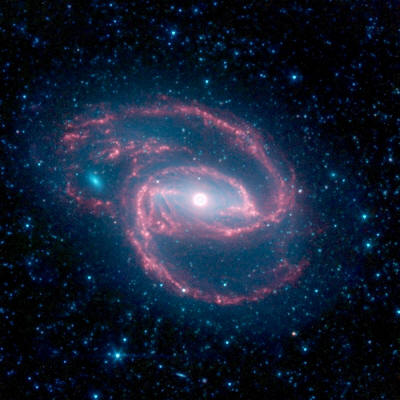
The galaxy in the photograph is spiral-shaped, like our Milky Way,
and extends long arms of red stars into space.
But NASA said the
black hole at the centre of the galaxy in which Earth is situated is
tame by comparison to NGC-1097, with the mass of just a few million
suns.
"The fate of this black hole and others like it is an active area of
research," said George Helou, deputy director of Nasa's Spitzer
Science Center at the California Institute of Technology in Pasadena.
"Some theories
hold that the black hole might quiet down and eventually
enter a more dormant state like our Milky Way black hole."
It should be painfully obvious to anyone that all galaxies are
falling into all other galaxies.
The
Milky Way and Andromeda are
colliding. It seems, according to research this last year, that
Andromeda is falling towards us due to it having a smaller mass than
our own galaxy. Both Andromeda and the Milky Way are falling towards
the
Great Attractor, a monster cluster galactic system. The reason
NGC-1097 is so excited is due to it devouring the small companion
galaxy.
The compression this is causing has already disrupted one of
the spiral arms and broken it apart. It will reform after the
smaller galaxy passes through and heads into the heart of the
system.
When the smaller black hole system merges with the greater one, this
will cause immense tidal forces that will range not only across the
entire galactic system but will extend outwards into the area around
the galaxy, disrupting the shoals of cosmic dust that is also being
vacuumed into this black hole complex.
THE MILKY WAY IS NOT DORMANT. It is simply moving. All these things
move in space and time!
As Andromeda gets closer and closer, the
'dormancy' of our own galaxy will become very excited and energetic
as the tidal forces move across the face of the galactic plane.
Supernova Waves Rolled Over Mammoths
Astrobio
September 28, 2005
A distant
supernova that exploded 41,000 years ago may have led to
the extinction of the mammoth, according to research that will be
presented by nuclear scientist Richard Firestone of the U.S.
Department of Energy's Lawrence Berkeley National Laboratory
(Berkeley Lab).
Firestone, who conducted this research with Arizona
geologist Allen West, will unveil this theory at the 2nd
International Conference "The World of Elephants" in Hot Springs,
SD. Their theory joins the list of possible culprits responsible for
the demise of mammoths, which last roamed North America roughly
13,000 years ago.
Scientists have long eyed climate change, disease,
or intensive hunting by humans as likely suspects.
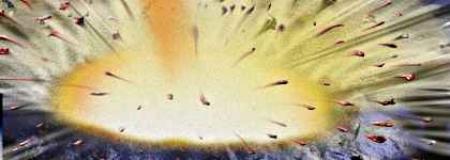
Now, a supernova may join the lineup.
Firestone and West believe
that debris from a supernova explosion coalesced into low-density,
comet-like objects that wreaked havoc on the solar system long ago.
One such comet may have hit North America 13,000 years ago,
unleashing a cataclysmic event that killed off the vast majority of
mammoths and many other large North American mammals.
They found
evidence of this impact layer at several archaeological sites
throughout North America where Clovis hunting artifacts and
human-butchered mammoths have been unearthed. It has long been
established that human activity ceased at these sites about 13,000
years ago, which is roughly the same time that mammoths disappeared.
They also found evidence of the supernova explosion's initial
shockwave: 34,000-year-old mammoth tusks that are peppered with tiny
impact craters apparently produced by iron-rich grains traveling at
an estimated 10,000 kilometers per second.
These grains may have
been emitted from a supernova that exploded roughly 7,000 years
earlier and about 250 light years from Earth.
This can't be a supernova event since it hammered ONLY North
America.
I subscribe to the 'blow up of a comet' theory for this
reason. It destroyed the wildlife and humans who hunted these things
but only in the Great Plains, not in Central or South America or
even the Arctic circle region where there was no ice such as Alaska
or Siberia in Eurasia.
Earthquake
Shift Puts Kiwis Closer to Aussies in Distance Only
Bloomberg
July 26, 2009
Rob Valentine, the mayor of Hobart in Australia's island state of
Tasmania, says New Zealanders should be thankful their biggest
earthquake in 78 years pushed the neighbors 30 centimeters (12
inches) closer.
"They're just that little bit closer to paradise," Valentine said.
"As neighbors, we're really close, we can work together to
take on the rest of the world."
The magnitude 7.8 quake on July 15, the strongest in the world this
year, struck off New Zealand's South Island, according to
seismological monitor GeoNet.
Hobart is the Australian city nearest
to New Zealand, separated by 1,530 kilometers (951 miles) of water
across the Tasman Sea.
Australia is rushing northwards faster than any tectonic plate on
earth.
New Zealand is simply a ring of volcanic activity excited by
this northwards trek. Australia is deforming the entire Pacific
Basin and is the cause of all the volcanic activity of this 'Ring of
Fire'.
And we might thank the Late Heavy Bombardment for the
existence of our landmasses.
After all, I fear that maybe, there
would not have been this 'soup' of lighter materials to ride on top
of the iron core, if there wasn't a sudden surge in the amount of
interplanetary matter!
Maybe, all our landmasses are really the
Asteroid planet!
|












